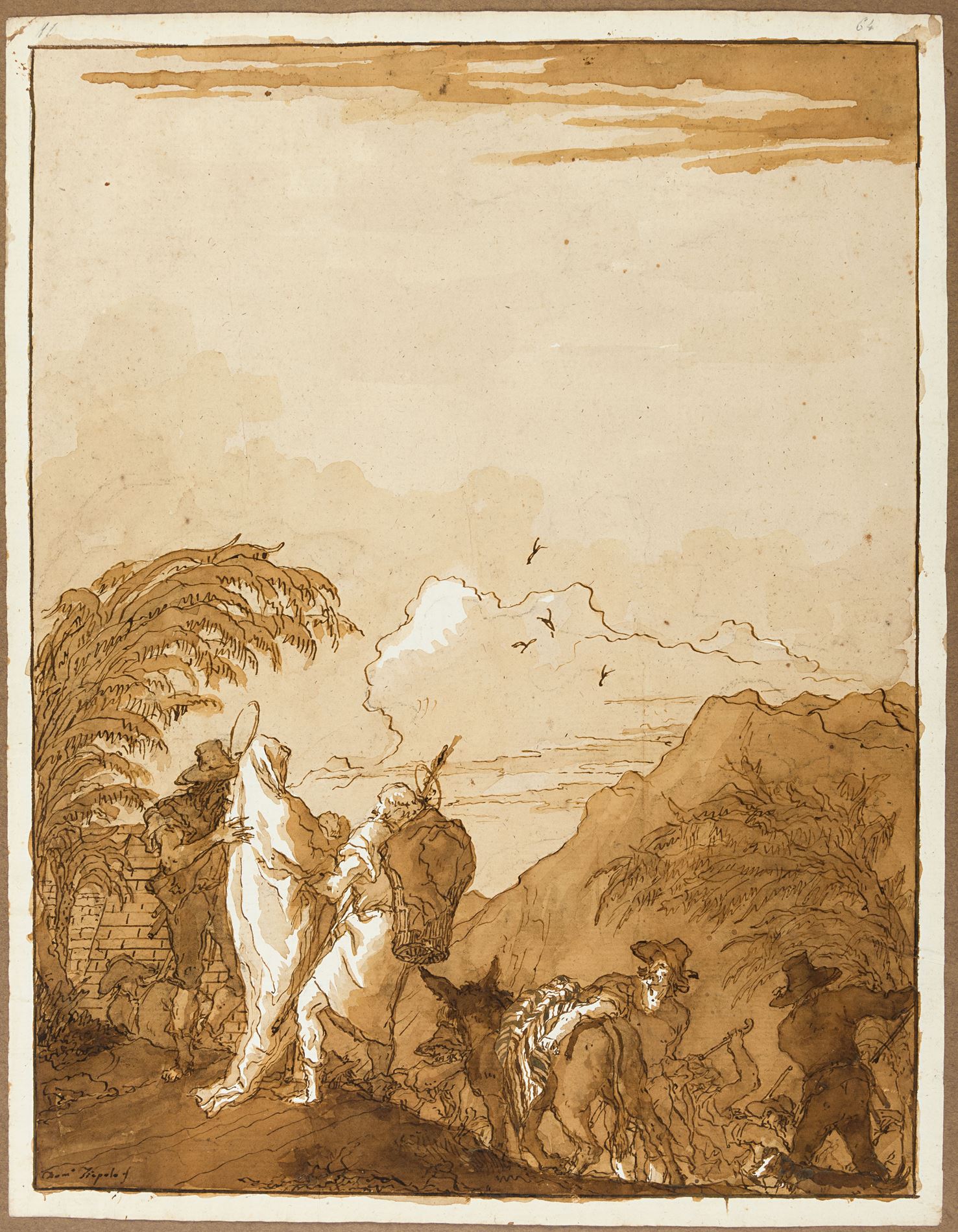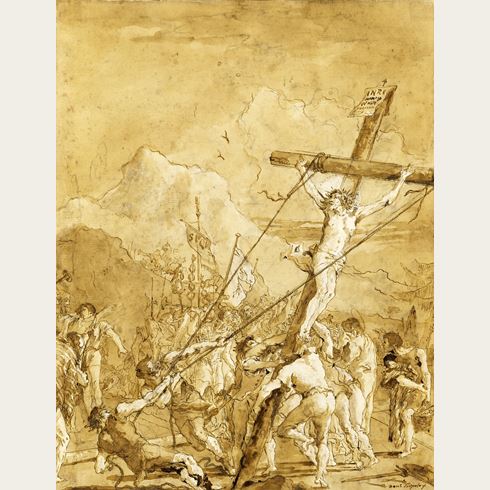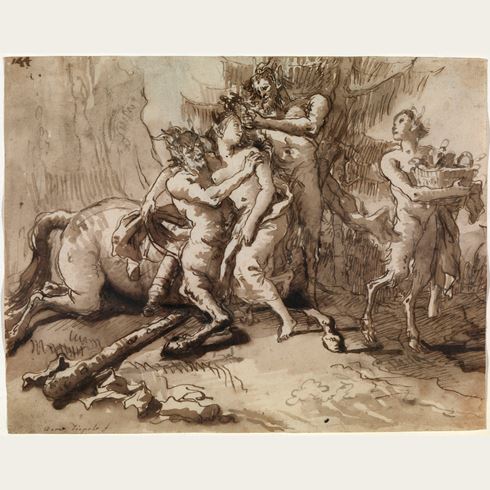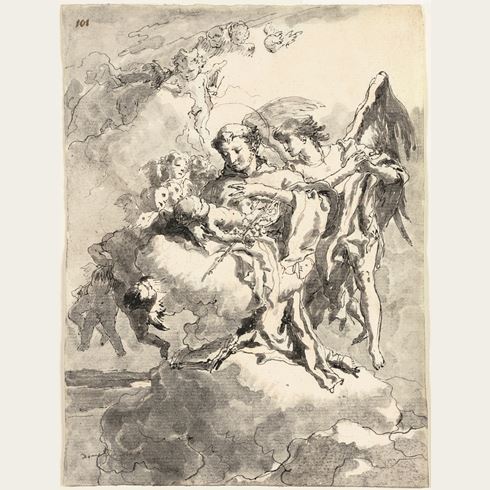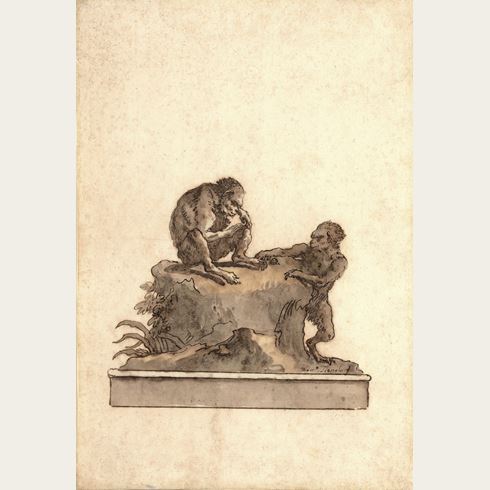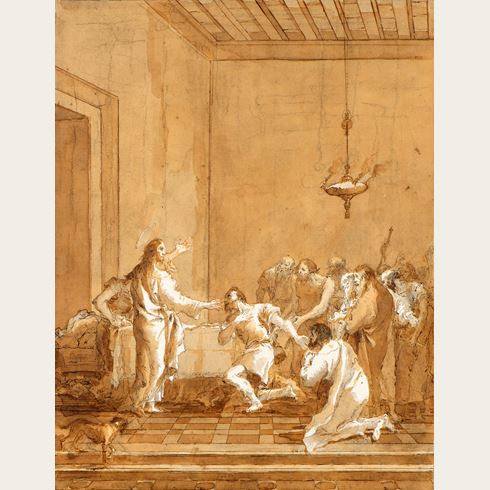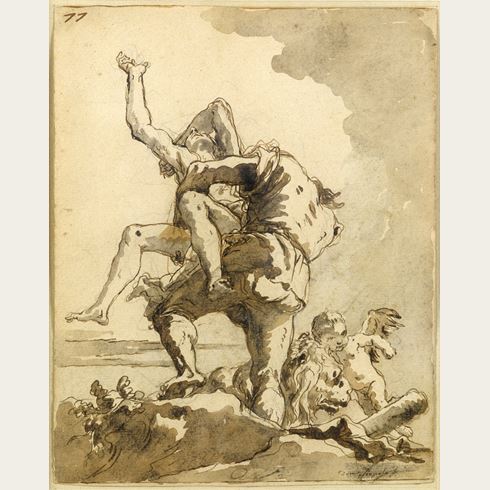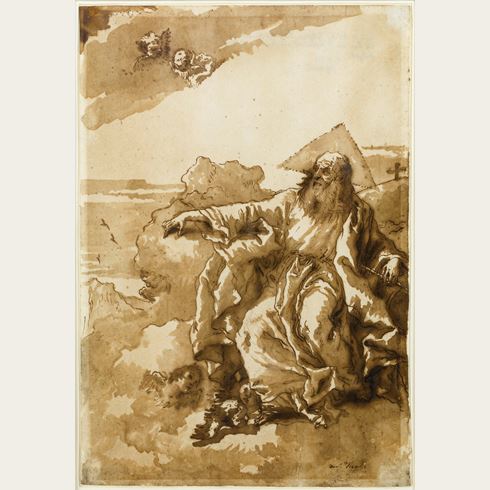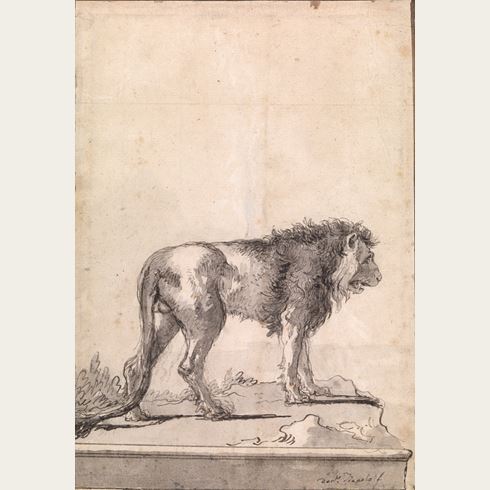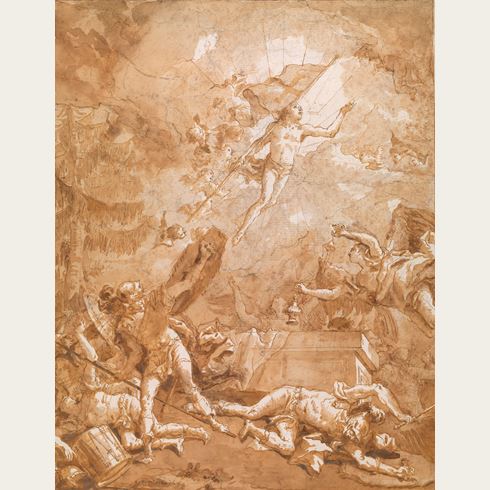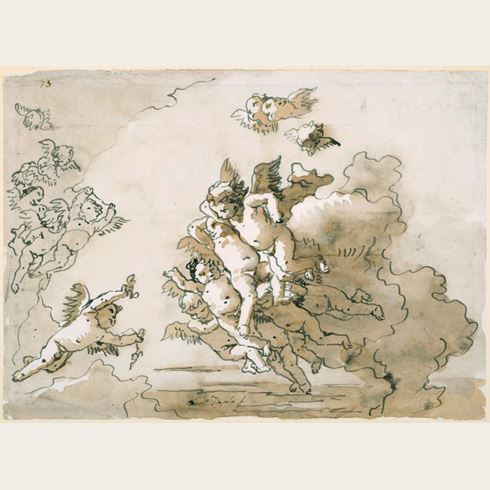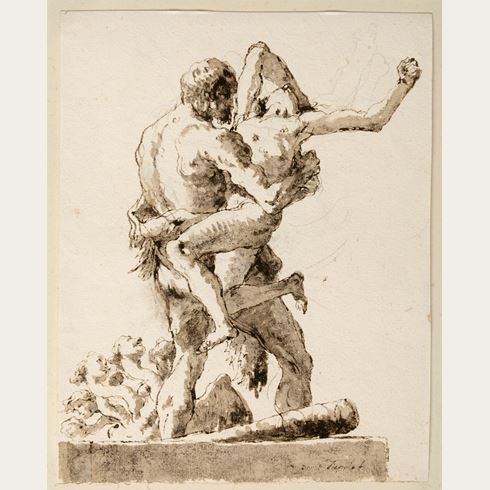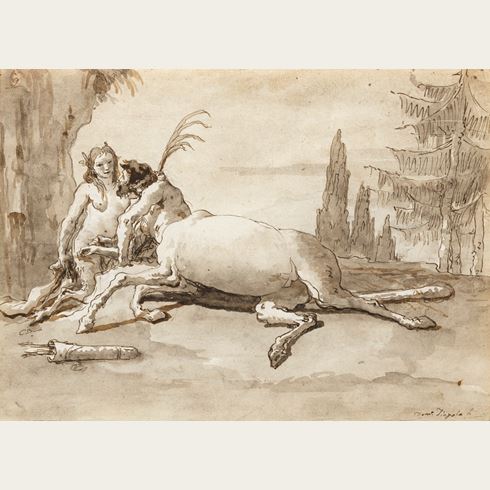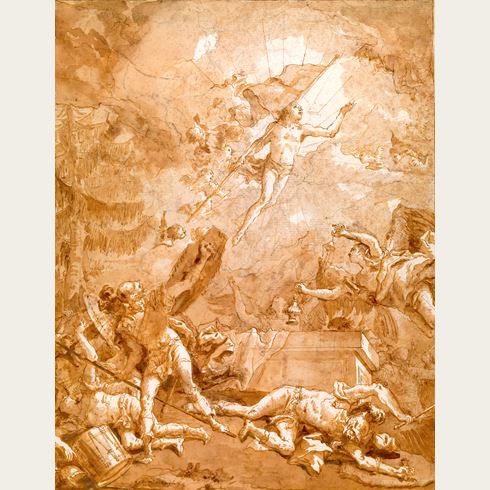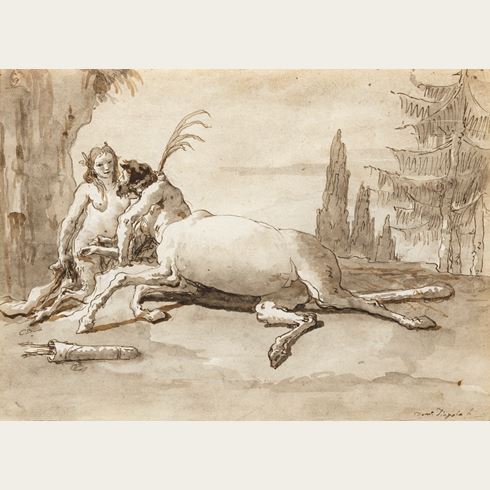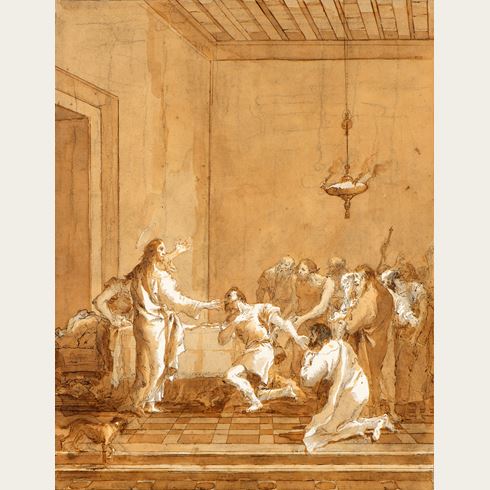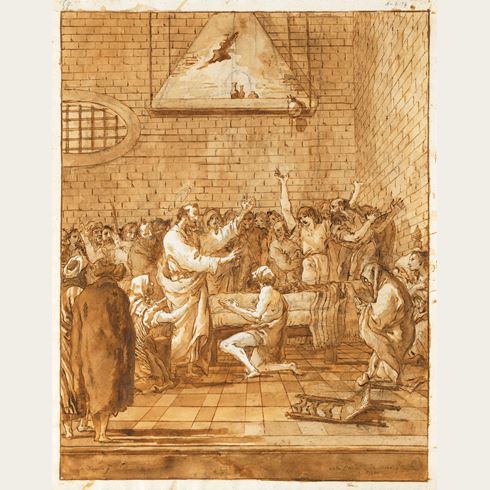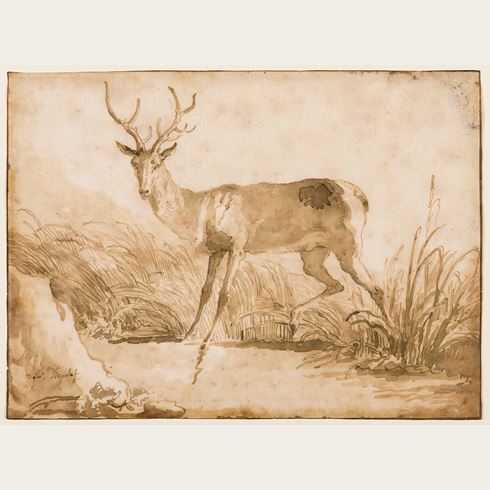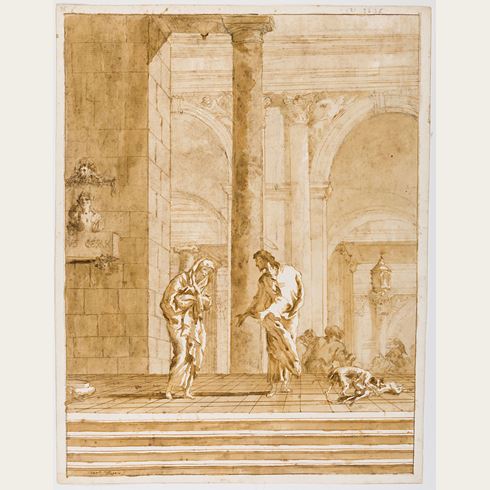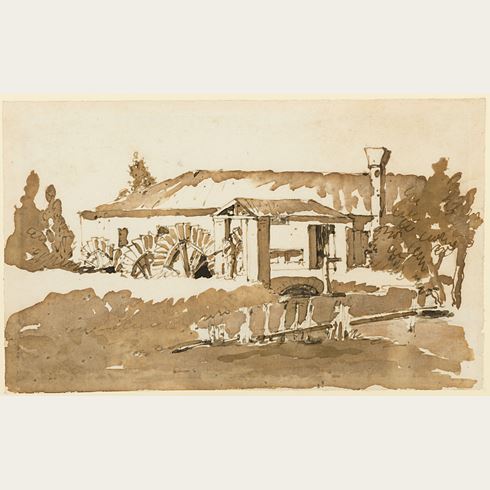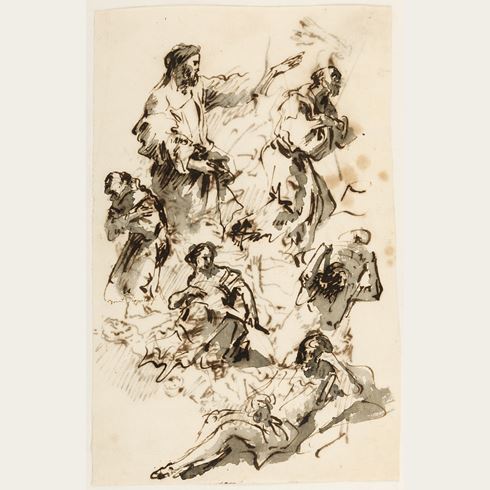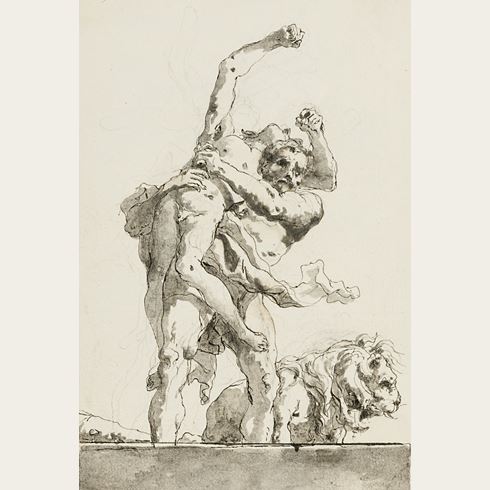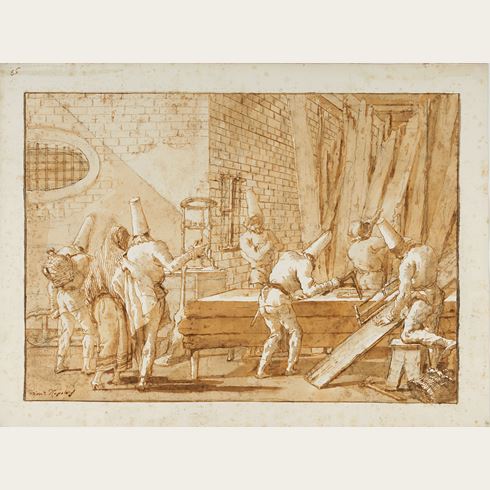Giovanni Domenico TIEPOLO
(Venice 1727 - Venice 1804)
The Holy Family Meet the Robbers
Signed Dom.o Tiepolo f. at the lower left.
Numbered 11 in the upper left margin and 64 in the upper right margin.
468 x 358 mm. (18 3/8 x 14 1/8 in.) [image]
492 x 380 mm. (19 3/8 x 15 in.) [sheet]
While it has been proposed that these drawings may have been intended as book illustrations, the fact that many of the compositions are signed in full would suggest instead that they were always regarded by the artist as independent, finished works. Byam Shaw notes that, ‘They are essentially 'album drawings', intended not as studies for painting or etching, but as works of art in their own right; and they belong to a period when drawing, rather than painting, was Domenico’s chief occupation.’
Set in elaborate interior or landscape settings, the drawings of the ‘Large Biblical Series’ are among Domenico’s masterpieces as a draughtsman, executed with an assurance of handling and a fluidity of tonal washes that is often quite breathtaking. As George Knox has written, ‘[Domenico Tiepolo’s] most extensive and perhaps his most remarkable work as a draughtsman...The Large Biblical Series is a summation in more ways than one. For the first time, Domenico draws on the full resources of the Tiepolo studio, his own visual memory, his folios of drawings, and the vast accumulation of drawings by his father...Even so, by far the greater part of these compositions are entirely original inventions.’ It is likely that the artist kept the drawings in his studio until his death, as no prints were made of them.
Long held in a French private collection and never before exhibited, this large drawing of The Holy Family Meet the Robbers is a previously little-known example from Domenico Tiepolo’s‘Large Biblical Series’. The subject is taken from the so-called ‘Arabic Gospel’ or ‘Syriac Infancy Gospel’; a compilation of apocryphal stories about the infancy of Jesus, derived from a now-lost Syriac manuscript of the 5th or 6th century that became known to Western audiences after being published in an Arabic and Latin translation in the late 17th century. The present sheet depicts the obscure story of the Holy Family’s encounter with robbers during their Flight into Egypt, as recounted in the ‘Arabic Gospel’:
‘In their journey from hence they came into a desert country, and were told it was invested with robbers; so Joseph and Mary prepared to pass through it in the night. And as they were going along, behold, they saw two robbers asleep in the road, and with them a great number of robbers, who were their confederates, also asleep. The names of these two were Titus and Dumachus; and Titus said to Dumachus, I beseech thee let those persons go along quietly, that our company may not perceive anything of them: but Dumachus refusing, Titus said again, I will give thee forty groats, and as a pledge take my girdle, which he gave him before he had done speaking, that he might not open his mouth, or make a noise. When the Lady St. Mary saw the kindness which this robber did show them, she said to him, The Lord God will receive thee to his right hand, and grant thee pardon for thy sins. Then the Lord Jesus answered, and said to his mother, when thirty years are expired, O mother, the Jews will crucify me at Jerusalem; and these two thieves shall be with me at the same time upon the cross, Titus on my right hand and Dumachus on my left, and from that time Titus shall go before me into paradise.’ (8:1-7).
This drawing is one of four episodes depicting the Holy Family and the robbers that Domenico Tiepolo included in the ‘Large Biblical Series’. A drawing in the Recueil Fayet in the Louvre seems to show a slightly earlier moment in the story, with the Holy Family’s initial encounter with the brigands causing Joseph to raise his arms in alarm. By contrast, in the present sheet, ‘Having befriended the robbers, the Holy Family goes home with them. Only the Virgin’s silhouetted form hints at fear or danger. As a palm tree leans protectively toward her…the robbers lead the donkey off in the distance…Since all the figures in this drawing are calm, this must represent the second episode, when the robbers are no longer threatening.’ Two further ‘Large Biblical Series’ drawings depict later episodes in the story, with the Holy Family arriving at the farm of the good thief, in a drawing now in the Pierpont Morgan Library in New York, and the Holy Family leaving the same farm to continue on their journey, in a drawing in the Musée des Beaux-Arts et d’Archéologie in Besançon. Neither of these two subjects appears in the ‘Arabic Gospel’, however, and Domenico Tiepolo may have used the 4th or 5th century apocryphal Gospel of Nicodemus as a source.
The figure of the Virgin in the present sheet, seen from behind and holding the Christ Child in her arms, is derived from one of Domenico’s etchings from his series of The Flight into Egypt, published in 1753.
In his pioneering book on the drawings of Domenico Tiepolo, published in 1962, James Byam Shaw opined that, ‘it is with the pen and brush, in the second half of his career, that Domenico develops his most characteristic style. It is then that his compositions – in the large Biblical series particularly – become much more pictorial than his father’s, for all the freedom and looseness of his pen work; and it is his peculiar use of the wash, brown or grey or both combined, which contributes most to this effect. These were album-drawings, finished to a margin-line, such as his father seldom produced...Such drawings were intended no doubt for the collector’s portfolio, but many others he kept for his own use.’
Giovanni Domenico Tiepolo is assumed to have begun his career in the family studio by copying his father’s drawings, although he also created his own drawings as designs for etchings, a practice which occupied much of his time in the 1740s and 1750s. His first independent drawings for paintings are those related to a series of fourteen paintings of the Stations of the Cross for the Venetian church of San Polo, completed when he was just twenty. Between 1750 and 1770, Domenico worked closely with his father as an assistant, notably in Würzburg, at the Villa Valmarana in Vicenza and the Villa Pisani at Strà, and in Madrid. From the late 1740s he also began to be entrusted with his own independent commissions, and the drawings for these display a manner somewhat different from that of his father, with a particular interest in lighthearted genre motifs.
Soon after Giambattista Tiepolo’s sudden death in Madrid in 1770, Domenico returned to his native Venice, where he enjoyed much success as a decorative painter. He continued to expound the grand manner of history painting established by his father - the ‘Tiepolo style’, as it were – and by 1780 his reputation was such that he was named president of the Accademia di Belle Arti in Venice. Within a few years, however, he seems to have largely abandoned painting. In his sixties and living effectively in retirement at the Tiepolo family villa at Zianigo, on the Venetian mainland, he produced a large number of pen and wash drawings that are a testament to his inexhaustible gift for compositional invention.
For much of the last twenty years of his career, Domenico Tiepolo seems to have painted only occasionally, and instead worked primarily as a draughtsman, producing a large number of pen and wash drawings that may collectively be regarded as perhaps his finest artistic legacy. These drawings were, for the most part, executed as a series of several dozen or more themed drawings, many of which were numbered. Among these are several series of drawings of religious and mythological subjects, as well as a varied group of genre scenes, numbering around a hundred sheets, generally referred to as the so-called ‘Scenes of Contemporary Life’, and a celebrated series of 104 drawings entitled the Divertimenti per li regazzi, illustrating scenes from the life of Punchinello, a popular character from the Commedia dell’Arte.
Domenico’s highly finished late drawings, almost all of which were signed, were undoubtedly intended as fully realized, autonomous works of art. While it is certainly possible that they were produced as works of art to be offered for sale to collectors, almost none of the drawings appear to have been dispersed in Domenico’s lifetime. The fact, too, that many of the drawings are numbered, possibly by the artist himself, and that most remained together in groups for many years after his death, would also suggest that they were retained in his studio throughout his life, as indeed he also kept numerous albums of drawings by his father. It is most likely, therefore, that these late drawings by Domenico were done simply for his own pleasure. Nevertheless, they have consistently enjoyed immense popularity since the artist’s death, and continue to entice collectors today. As Catherine Whistler has noted, ‘Domenico’s spirited and inventive independent sheets have long been appreciated, particularly by French and American collectors of the late nineteenth and early twentieth centuries; his quirky sense of humor, acutely observant eye, and zestful approach to his subjects lend his drawings a peculiarly modern appeal.’
As Michael Levey has also noted of the artist, ‘Domenico Tiepolo’s drawings provide us with the more private side of him, but they also serve to represent his career at all stages. He drew continually: sometimes very closely in the manner of his father; at the opposite remove, in the late Punchinello drawings for example, his manner and matter could never be mistaken for anyone else’s...The key to Domenico is in drawings: he began as a draughtsman and, one is tempted to say, all his paintings betray the draughtsman.’
Provenance
Dispersed on the Venetian art market in the first half of the 19th century
Victor Luzarche, Tours, until 1868
Camille Rogier, Paris
Roger Cormier, Tours
His sale (Collection de M. Cormier de Tours. Dessins par Giovanni-Domenico Tiepolo), Paris, Georges Petit, 30 April 1921, lot 37 (La Fuite en Égypte: la Sainte Famille arrivant en vue d’une ville. Plume et lavis de sépia. Haut,. 47 cent.; larg., 36 cent.)
Galerie J. Kugel, Paris
Private collection, France.
Literature

